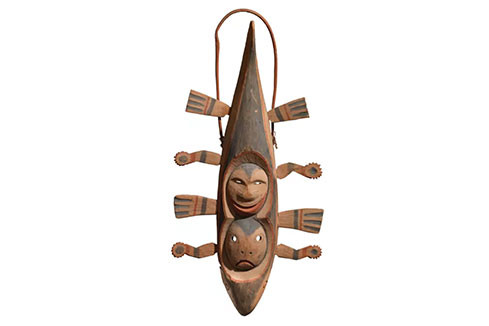
Celebrating Two Thousand Years of Inuit Art
Financial Times
A full-page article in the Financial Times reviews Two Thousand Year of Inuit Art, on view at Frieze Masters 2017. With this ‘bravura display,’ Susan Moore notes, Donald Ellis Gallery celebrates ‘some of the finest examples of art’ from the Arctic region of North America.
‘Ellis is the pre-eminent specialist dealer in ivory and arguably its most ardent advocate,’ the author writes. Some of the earliest works on show are prehistoric marine mammal ivories carved in human and animal forms. Two thousand years later, famed Canadian artist Parr (1893-1969) would record the traditional nomadic hunting life of the Inuit in graphite and crayon. The exhibition also showcases the highly abstracted contemporary soapstone sculpture of Andy Mikki and John Pangnark.
For Moore, it is the Yup’ik masks that inevitably steal the show. These works ‘are among the most inventive, expressive and fantastical of all tribal arts,’ she writes. Many of the exhibited works were once in the private collections of Surrealist artists Enrico Donati, Roberto Matta and Robert Lebel. During their exile in New York, many Surrealists haunted the Third Avenue gallery of Julius Carlebach that Max Ernst discovered in the 1940’s, intrigued by the visual arts of various Indigenous peoples. As the French-Swiss Surrealist Isabelle Waldberg wrote in 1943, ‘We threw ourselves into the poetic atmosphere of the Eskimo masks. We breathe in Alaska, we dream Tlingit, we make love in Haida totem poles. Carlebach’s place on the Third Avenue has become the place of our desires.’
In a room of its own, Donald Ellis Gallery is showcasing an exceptional Yup’ik dance mask from about 1890-1905, which belonged to the Italian-American Surrealist painter and sculptor Enrico Donati (1909-2008). Visually arresting, the museum-quality mask represents Oangiluk, the rain spirit that brings the warm south winds, and was danced during Winter Ceremonies to ensure sustenance in the coming year. The mask is the most important example remaining in private hands. ‘The last such work to reach the market had been exhibited in MoMA’s seminal Primitivism in 20th Century Art show of 1984-85,’ Moore reports, ‘before being bagged by Ernst Beyeler for his foundation in Basel.’
Download Celebrating Two Thousand Years of Inuit Art Clipping




